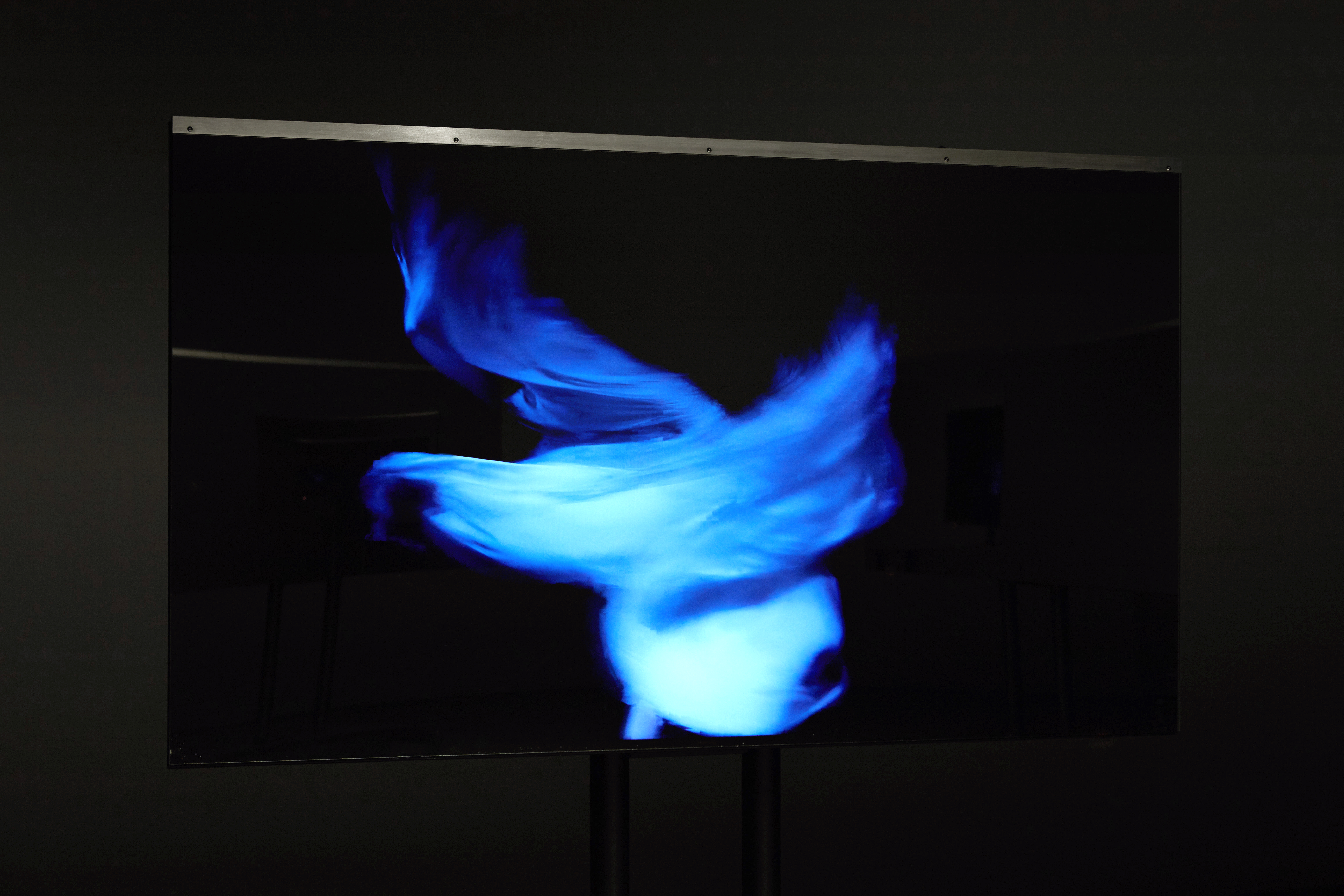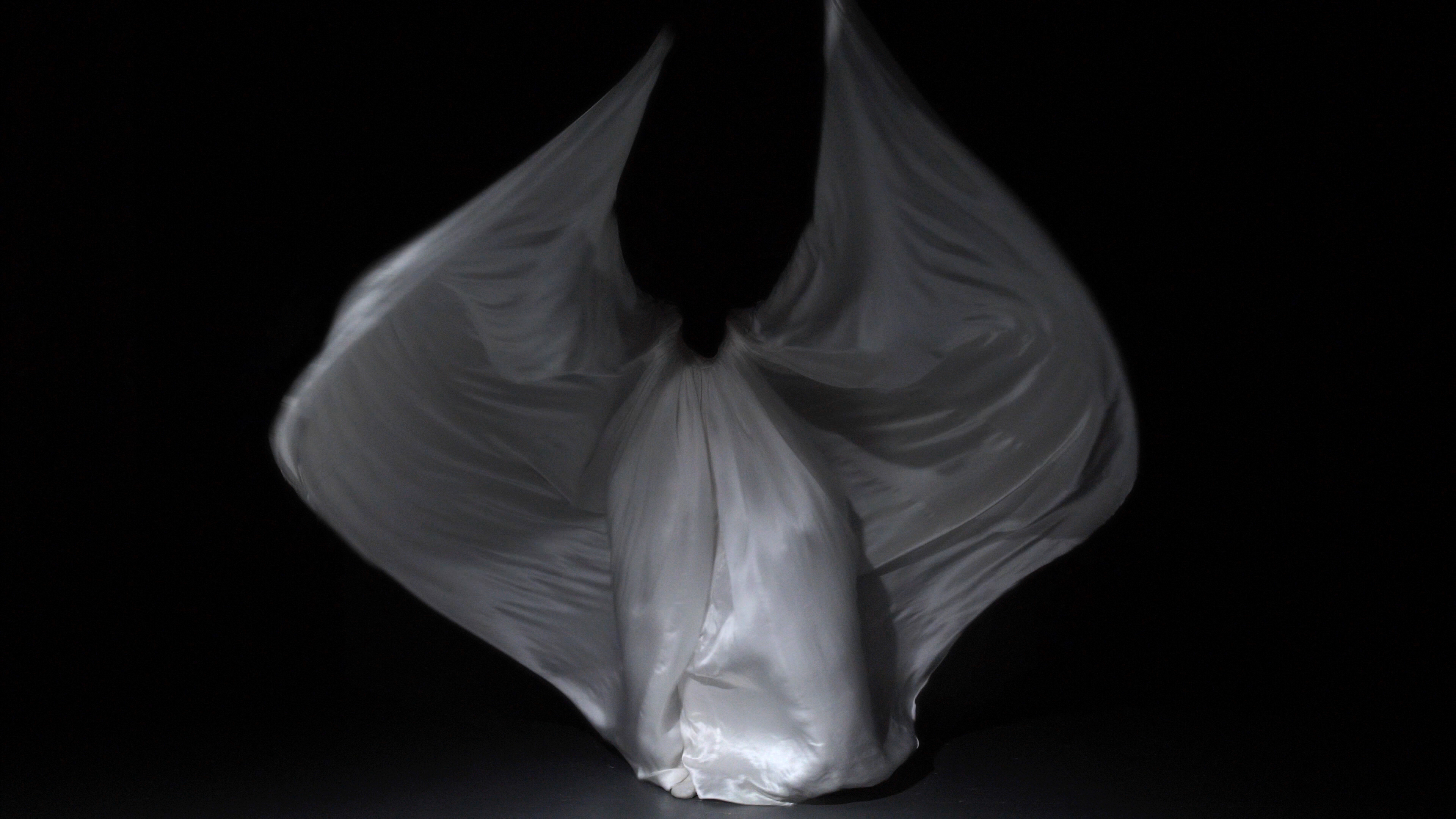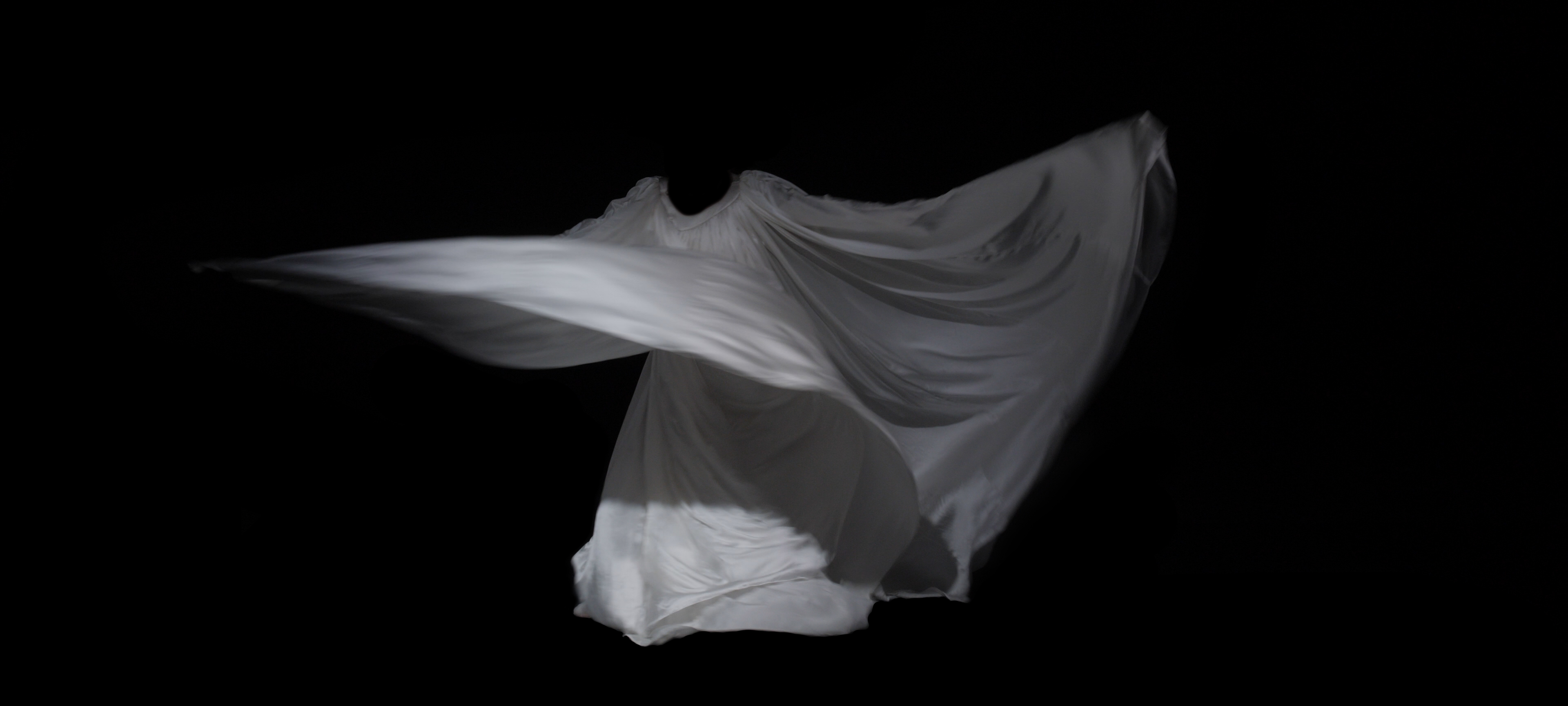Jenn E Norton: Slipstream at Kitchener-Waterloo Art Gallery
June 26 – September 22, 2019
September 9, 2019 by Danica Evering

Jenn E Norton, Slipstream (video still), 2018. 6-channel video installation, 10:40 min. Courtesy of the artist. © Jenn E Norton.
This text is a response to Jenn E Norton’s exhibition, Slipstream (2018). The exhibition consists of an immersive installation under the same name. A multi-channel video of a dancer wearing a silk robe stretches across six large mirrored video screens, arranged in a ring in the dark gallery space. Bringing together Art Nouveau aesthetics, augmented reality, and 19th-century technologies, Norton considers Loïe Fuller’s (1862 – 1928) often-imitated serpentine dance and mirror room apparatus. A dancer, inventor, chemist, and designer, Fuller is recognized as an innovative figure of both modern dance and projection technology. Jenn E Norton is a Guelph-based artist whose work in interdisciplinary media (video, installation, sound, and kinetic sculpture) often explores technology and design histories, visualizing invisible forces and uncanny imaginaries.
Curated by Linda Jansma and Crystal Mowry, the show is touring through six art spaces in off-centre cities. It is currently at the midpoint, having travelled from exhibitions at the Robert McLaughlin Gallery in Oshawa and Mount Saint Vincent University Art Gallery in Halifax. It will continue on to the Judith & Norman Alix Art Gallery in Sarnia (October 4-January 5, 2020), Kelowna Art Gallery in Kelowna (Spring 2020), and Dunlop Art Gallery in Regina (Fall 2020). This reflection comes out of a conversation with Norton (cross-legged on the floor) within the installation in the Kitchener-Waterloo Art Gallery, which runs from June 26 to September 22, 2019.
I. The Circle
Slipstream: a current of air or water driven backwards by a spinning propeller. She has placed six large screens in a ring in a dark room. A dancer in a fluttering silk robe moves around us from screen to screen tossing her arms up and down like great wings. An immense sound circles, a rhythmic chopping. In sprays of white silk underlit by technicolour light, you read shifting forms: flower, cloud, bird, flame, butterfly, wave, snake. Jenn E Norton’s travelling exhibition spirals into the past, returning to dancer, chemist, stage designer, and inventor Loïe Fuller—or perhaps pulling her into the present, or both. Norton explores Fuller’s serpentine dance. Part skirt dance, costume, and early experimental projection surface, it was central to Fuller’s popular stage performance at the Folies Bergère in the late 1800s. I am reminded of Janet Cardiff revisiting Tallis’ 40-part motet. A circle is a container, to be inside it feels holy. The video rises and falls; it has the narrative crescendo of any good performance. Yet the beginning bleeds into the end. Being born is a little like dying. Can a loop have a beginning?

Jenn E Norton, Slipstream (installation detail), 2018. 6-channel video installation, 10:40 min. Courtesy of the artist and the Kitchener-Waterloo Art Gallery. Photo: Tyler Young © Jenn E Norton
II. The Gap
Before I talk about the screens first I need to tell you about the spaces between them. My eyes follow dancer Katie Ewald’s video presence as she crosses the screen, and then there is space, a moment in time when “she” exists in the gap. I can’t see her, she has disappeared from the screen. But she is there, running for a few heartbeats (with the eccentric small-stepped gait Fuller was famous for) through the space between. As we sit cross-legged on the floor, Norton tells me about Zeno’s paradox. Zeno imagined an arrow in flight. In each given instant we look at it, it is occupying a space at rest, motionless. Time is entirely composed of instants. As the arrow flies from the archer’s crooked fingers to thud taught at the target’s trembling heart, it flickers in the air through dozens of instants: points of stillness that we understand to be motion as we draw a line in the gaps between. Video itself is a set of still images that we read as motion in the aggregate. A gap bridged by a cognitive leap.
III. The Mirror
No one true. The screens are slick, shiny as a mirror and showing myself back to me as much as they display the video. Surely she has placed six large reflective screens in a ring intending this slippage between my physical standing form and the life-sized dancer. The screens’ placement and surfaces are the second of Fuller’s inventions Norton has drawn into this space: a mirror room patented in 1893. This ring of mirrors (aligned just so) allowed Fuller to dissolve into herself, hundreds of identical women moving in unison. Those who saw her dance in the moment were awe-struck, wondering which was the real person and which the reflection. [1] Flickering between actual and image, suspending disbelief. Unlike Fuller’s mirrors lining up perfectly to create the illusion of an infinitely unfolding mass ornament, [2] these mirrors are slightly oblique. They reflect imprecisely, my reflection ends after three repetitions. There is something humble about this result—a spectacular optical environment (thinking of other mirrored rooms) does not eclipse the experience. These mirrored angles are more oblique, complicating the reading and pulling in those between them.

Jenn E Norton, Slipstream (installation detail), 2018. 6-channel video installation, 10:40 min. Courtesy of the artist and the Kitchener-Waterloo Art Gallery. Photo: Tyler Young © Jenn E Norton

Jenn E Norton, Slipstream (installation detail), 2018. 6-channel video installation, 10:40 min. Courtesy of the artist and the Kitchener-Waterloo Art Gallery. Photo: Tyler Young © Jenn E Norton
IV. The Invisible
I can’t see the air but Norton and Fuller remind me it’s there. Each sweep of the Serpentine Dance’s giant wing shows its force, guttering and stirring up currents. In sprays of white silk I read other invisible forces which share our space: light, heat, electricity, sound, data, radio waves. A slipstream, a current of air propelled by the dancer’s whirling arms underneath backwards in time. I remember that our bodies are not where our selves end. We extend outwards with each movement, each sound we make pushing molecules in the air. Tiny impacts and gaps, impacts and gaps until it reaches a listener. Covert instants strung together in a long trajectory. Fuller’s invention makes visible the invisible, something Norton is similarly interested in. La fée d’electricité, an electric spirit. I can’t perceive the air’s power, until I push against it.
V. The Grasp
My eyes follow the dancer’s sweeping presence as she crosses the screen, and then one sweep turns into a brushstroke. A thick metallic 3D trace lingers, holding the gesture (though nothing can truly linger in video, and so in a few moments it disappears). It feels in the same vein as experiencing something out of the ordinary in public. Did you see that? These are gleaming tendrils, referencing Art Nouveau’s metals and curves of those who would have been Fuller’s architectural contemporaries. Within the video itself they are very sparing, traces that hint at the many loops and curls visible in an earlier augmented reality facet of the installation that the low light of the exhibition space made technically unattainable. The gesture is fleeting and this trace makes it sculptural, gives it weight and a shape. Like Zeno’s arrow, the 3D trace holds the instant against the fluid passing of time. A moment held then fading.

Jenn E Norton, Slipstream (video still), 2018. 6-channel video installation, 10:40 min. Courtesy of the artist. © Jenn E Norton.

Jenn E Norton, Slipstream (video still), 2018. 6-channel video installation, 10:40 min. Courtesy of the artist. © Jenn E Norton.
VI. The Matter
Can a loop have an end? Carefully, admiringly, Norton both pulls Fuller into the present and returns to the other’s past. It is an earnest, tender connection across time. Genes, words, seeds, inventions. There are many ways to reach the future. Each is unstable. Each portal can be temporary, unexpected, inconsequential, significant, dormant. Fuller was an innovator (mirror room patented), the great-great-grandparent of a field, though for a large part she dissolved into herself. Her arrow has appeared in instants, lit up by scholars, writers, artists, and admirers in the century that followed. Norton is conceptual kinfolk with theoretical physicist Karen Barad, who writes about matter(ing) across time. Barad writes, “remembering is not a replay of a string of moments, but an enlivening and reconfiguring of past and future that is larger than any individual.” [3] Through this multifaceted act of remembering, Slipstream enlivens an active relationship that goes beyond cause and effect. Something more interactive, circular, and relational, it proposes connections across time. A charge. Between solid things—flesh, silk, atoms—and the spaces between them—idea, resistance, imaginative leap. An arrow flickering through time but never reaching a target. An electric spirit, crackling through the gap between cloud and ground.
[1] Rhonda K. Garelick, Electric Salome: Loie Fuller's Performance of Modernism, (Princeton: Princeton University Press, 2009), 45-46.
[2] Sigfried Kracauer, The Mass Ornament: Weimar Essays (Berlin: Suhrkamp Verlag 1963; Cambridge: Harvard University Press, 1995).
[3] Karen Barad, Meeting the Universe Halfway: Quantum Physics and the Entanglement of Matter and Meaning (Durham: Duke University Press, 2007), ix.
Danica Evering was born in Cobourg and lives in Hamilton, ON. Through writing, organizing, sound composition, and curation, they work through difficulty and belonging, reaching out intentionally, and complicating narratives. Their SSHRC-supported MA in Media Studies from Concordia questions power dynamics and insider/outsider relationships in social practice through interviews with artists and creative analysis of their own field work. Evering’s semi-fictional writing has taken the form of audiosculptural biographies, soundwalks, and an experimental play. Their analysis has appeared in No More Potlucks, Lemon Hound, Public, and Kapsula, and other publications. They were a founding member of the editorial collective of Publication Studio Guelph, a sibling studio of an international publishing network that attends to the social lives of books, and participated in the creation and development of the Benčić Youth Council, a radical arts education program for youth in Rijeka.
